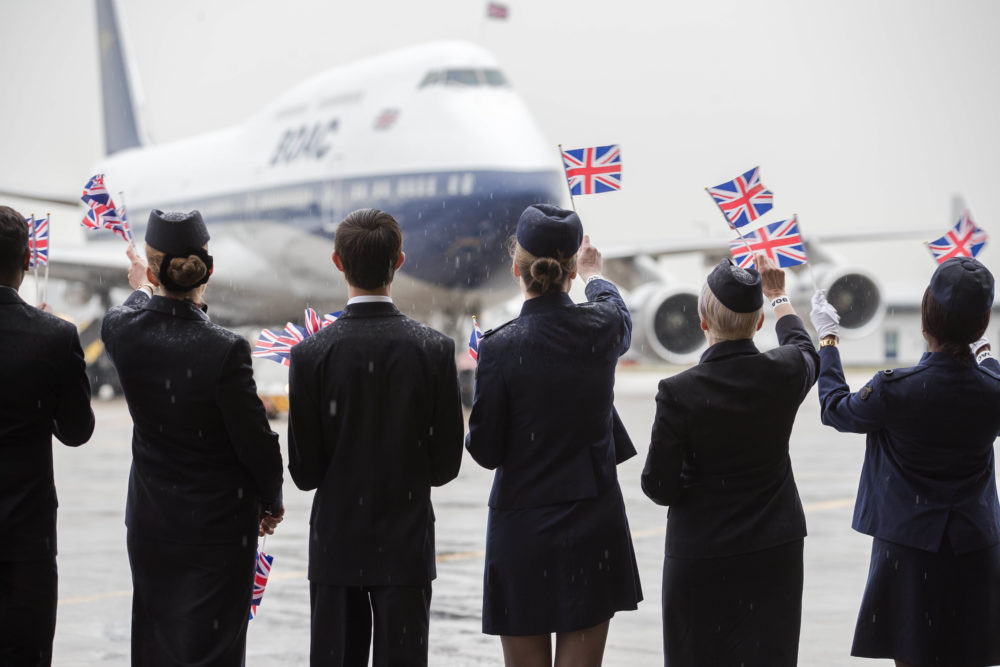British Airways was formed by the 1972 merger of Britain’s two state-owned flag carriers — British European Airways (BEA), which covered short and medium haul trips with an entirely British-built fleet of Tridents, BAC-111s, Viscounts and Vanguards, and British Overseas Airways Corporation (BOAC), which flew intercontinental with a fleet of British-built VC-10s and American Boeing 707s.
BOAC were considering all options including the stretched Douglas DC-8-63 and Vickers’ homegrown Super-Super VC-10, a re-imagined Super VC-10 that never left the drawing board. Factors that influenced BOAC towards the Boeing 747 included the obvious savings to be achieved, by flying 370 people in a single aeroplane, and a shortage of pilots that was expected to last into the foreseeable future.
In April 1966, BOAC purchased six Boeing 747s as performance forecasts from Boeing became more concrete. As the 747 design neared completion the true scale of the efficiencies that could be realised, by operating such a large and modern machine, became apparent and the board soon placed a follow-up order for another ten planes; with 20 percent of the purchase to be financed by BOAC’s ticket sales in the US, which were of course in dollars.
Around the time that the 747 deliveries were intended to begin, it was realised that a long-running pay dispute with pilots would endanger summer 1970 flying. The airline’s labour problems soon multiplied, as flight engineers insisted on retaining their two-night stopover privileges and cabin crew wanted extra “747 pay” and compensation for crew who weren’t selected to work on the jumbo. Pilots refused to start training until the disputes were settled.
The first jumbo for BOAC, and the twenty-third built was G-AWNA, was flown into London Heathrow on April 22nd 1970, followed by G-AWNB on May 6th and G-AWNC on May 28th.
However the machines were parked and stored while the dispute rumbled on. In fact this saved BOAC a considerable headache, as the early Pratt & Whitney JT9D engines on the 747-100 were extremely unreliable in service (the first ever 747 passenger flight, Pan Am’s inaugural New York to London trip on January 6th 1970, was delayed by nearly ten hours including an eventual aircraft change). BOAC was able to bypass these teething problems while their labour problems were ironed out; even leasing some of their engine inventory to other airlines, who desperately needed them as their own spares were rapidly being exhausted.
It wasn’t until early 1971 that contracts with pilots and cabin crew were settled and all nominated staff reported for training on March 1st, with 747s getting airborne on passenger services on April 14th.
The inaugural flight was to New York JFK operated by G-AWNF departing Heathrow at 12:03, under the command of BOAC’s 747 Flight Manager Captain D. Redrup.
Initially the frequency was twice weekly, reaching up to daily the following month. Within a year the 747 fleet was flying daily to Chicago and Miami, followed by Montreal, Bermuda and Toronto. Summer 1972 also included a Manchester-Prestwick-New York service.
The cabin layout was for 27 First Class passengers and 335 in Economy; in winter the configuration was changed to 36 First Class and 315 in Economy. First Class passengers also had the use of the Monarch Lounge in the upper deck, accessed by a spiral staircase, containing a luxurious hide-out for sixteen passengers, who could enjoy the services of a bartender and relax on settees and couches.
Although the merger with BEA was not formalised until March 31st 1974 the last 747-136 delivered in the BOAC livery, registerd G-AWNM, arrived at Heathrow on May 3rd 1973. Aircraft from then on were delivered in British Airways livery, in anticipation of the merger. The last 747-136 to be delivered was G-BDPV on April 4th 1976, by which time the jumbo was being flown extensively throughout the network; these trips included the bulk of transatlantic journeys over the North pole to Japan and also all the Australia and the New Zealand routes.
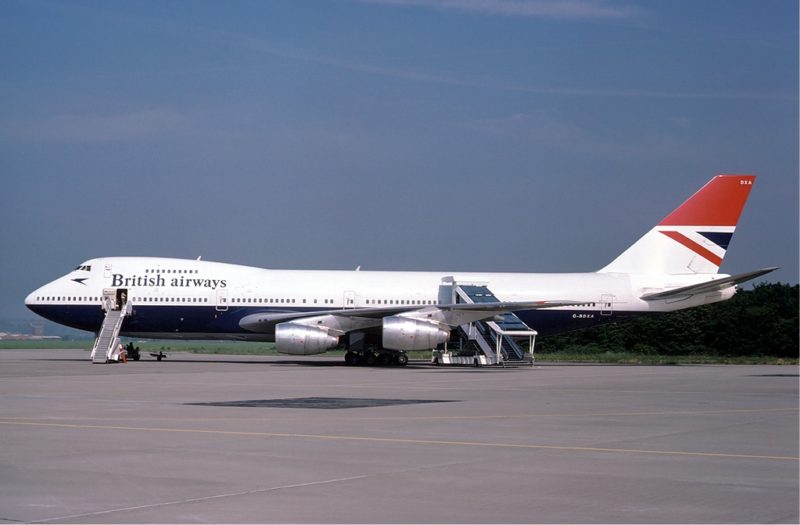
Rolls-Royce had created the RB.211 high-bypass turbofan for Lockheed’s L-1011 Tristar; a development so ambitious that it bankrupted Rolls, which survived only by being nationalised by the British government. Political pressure, to make the taxpayer’s investment profitable, may have been a factor for government-owned British Airways’ order for RB.211-powered 747-200Bs; but in any case the engine, with its unique triple-stage fan, was a world-beater. The prototype for the Rolls-powered 747s, which were also ordered by Qantas, Cathay Pacific, Air New Zealand, Malaysia, and Saudia, was G-BDXA and began test flying in September 1976. One memorable test flight saw XA lift off at a weight of 381.25 tonnes, at that time the heaviest aircraft in history.
One 747-236F pure freighter was delivered in October 1980, intended to be G-BDXK but aptly registered G-KILO. However, the economy in the early 1980s was soft so it was decided that the passenger 747 fleet, which had ample underfloor cargo capacity, was to be sold to Cathay Pacific in March 1982 (where it received another custom registration, VR-HVY).
On the night of June 24th 1982 G-BDXH made history as the world’s heaviest glider, when it flew without engine power for 12 minutes after flying into an unforeseen cloud of volcanic ash over Indonesia.
Luckily three of the engines were restarted after the machine glided clear of the ash cloud, a challenging but safe landing was then achieved by ace pilot Captain Eric Moody and his crew at Jakarta.
The final 747-236Bs were delivered during the period of 1987-1988, a trio with main deck side cargo doors; although they were never used as combis. Interestingly, Boeing were already manufacturing the horizontal stabiliser for the 747-400 which included integral fuel tanks; so although they were never plumbed in with fuel pumps, those ships had -400 stabilisers.
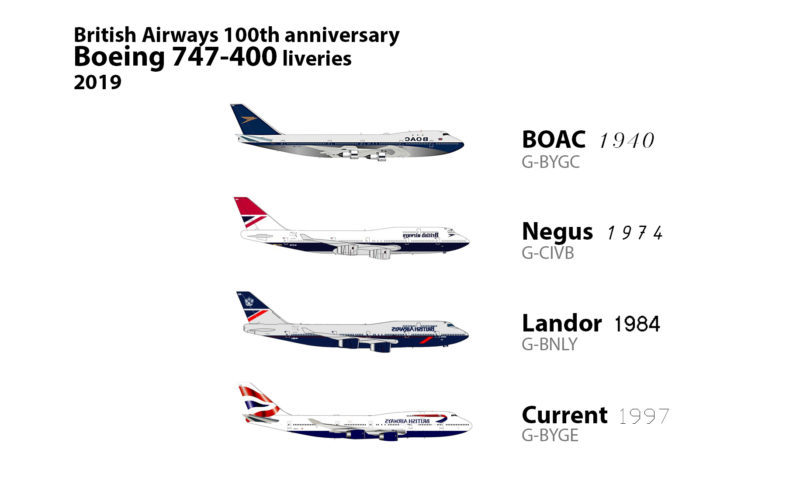

British Airways was one of the first airlines to place an order for the upgraded jumbo, with an initial order for 16 aircraft announced on August 16th 1986. As with the -200B, BA was the first airline to receive aircraft powered by Rolls-Royce engines. G-BNLA and LB were handed over to their new owner on June 30th 1989. The inaugural flight of the 747-400 in British Airways service took place on Thursday July 27th; with Speedbird 219 pushing back from Terminal 4 at Heathrow at 12:32 local time, bound for Philadelphia. It landed at 15:20 local time, before continuing on for the short hop to Pittsburgh where it landed at 17:50.
A week later, the 747-400 took over the trip to Detroit via Montreal. Multi-stop flights were favoured initially, as the extra sectors allowed more takeoffs and landings, giving the crew more opportunities to get type rated on the airline’s new flagship. The extra range of the -400 was used to its full extent on ultra long-haul non-stops to Singapore, Tokyo, Sao Paolo and Johannesburg; displacing the Classics, which then retreated to shorter trips such as Toronto, New York, Washington, the Persian Gulf and India.
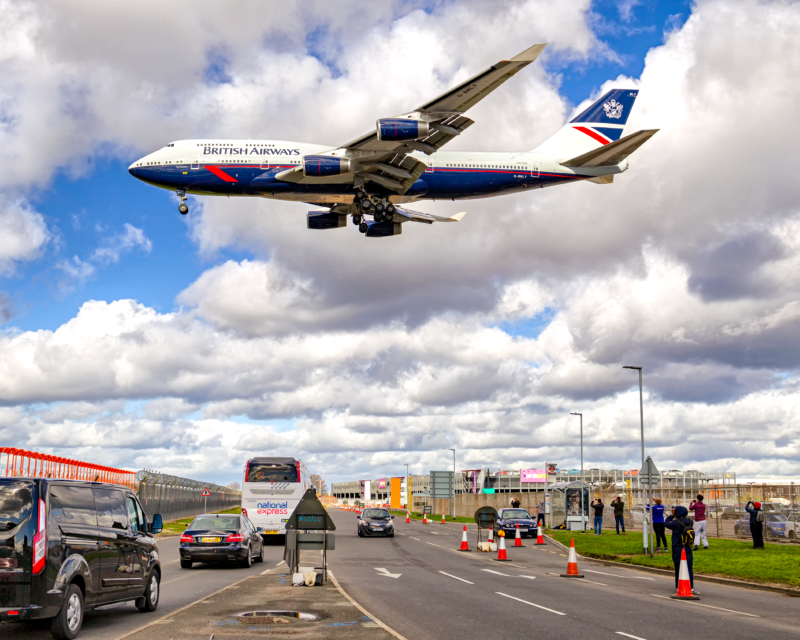
A new livery was introduced in 1997, known as the Utopia scheme, and was an innovative reflection of the wide range of global destinations served by British Airways; it included twelve different tail designs, based on ethnic art from every corner of the world. Whilst colourful and unique, some elements of the airline’s core customer base felt it diluted the “Britishness” of the brand; the tail design that had been created just for Concorde, a stylised Union flag known as the Chatham Historic Dockyard, was adopted fleet-wide in 1999.
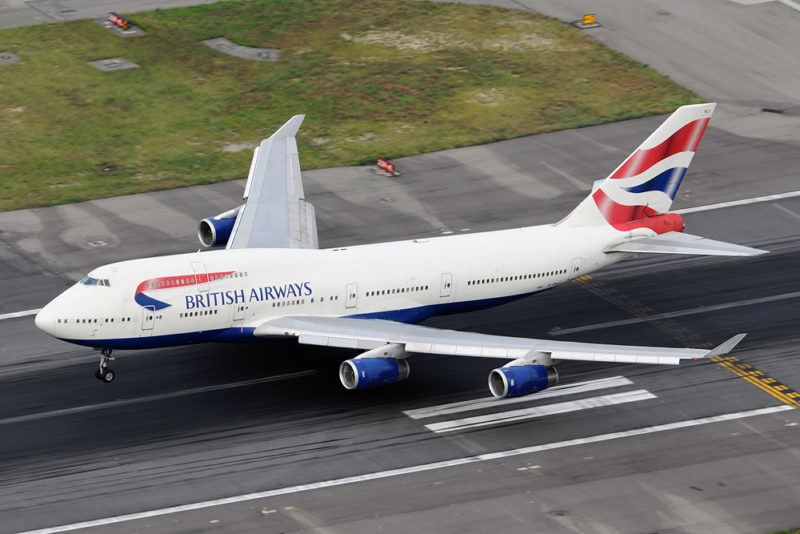
The only 747-200 to receive the Chatham Historic Dockyard livery was G-BDXB, as the Classics were coming up to retirement. The first to leave the fleet was BOAC’s first 747-136, G-AWNA, which exited from the fleet in Nov 1998; to mark the occasion she was painted in a basic BOAC livery for her final weeks of service, before being ferried to Bruntingthorpe to be scrapped. The last Classic to leave the fleet was a -236B, flying from Bombay to London on the last day of October 2001; the retirement plans were hastened by the post 9/11 downtown in air traffic.
In topping up orders for more of the 747-400s, British Airways requested a unique variant known as the 747 Lite.
By not plumbing in some of the auxiliary fuel tanks, the 747-400 Lite was re-certified with a lower maximum takeoff weight. The weight was reduced down from 396,900 kg to 381,000 kg, this meant an increase in payload by 6,000 kg and a decrease in landing and overflight fees. The only visible difference on these ships is found in the cockpit, where two fuel tank switches are replaced by a blank panel.
Further top-ups had raised the size of the 747-436 fleet to 50, yet British Airways had originally had plans for a total of 75. The final 25, representing an order for a further 100 engines, were to be powered by a special hybrid of the RB.211, which would utilise the core from the Trent engine. However, only nine of this final order were built. British Airways decided that 59 jumbos was enough, with deposits for the rest of the order being transferred to Trent-powered 777-236ERs. Interestingly, today those unique RB.211s, with the Trent core,turn up randomly on various British Airways 747s. With the sophisticated FADEC engine management software, they produce identical thrust to the rest of the engine pool; however they are notable in flight because they burn slightly less fuel and run with slightly lower exhaust gas temperatures (EGTs), which is usually the only way the operating crew will notice they have one of those engines along for the ride.
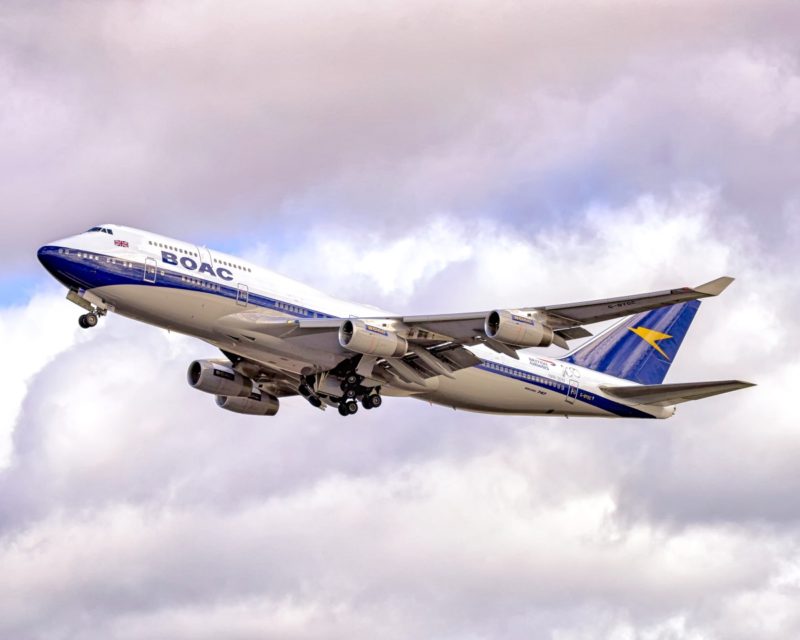
As well as innovating with technology, British Airways has always been at the cutting edge of passenger accommodation. In May 1977 they were one of the first airlines to introduce Business Class, starting with the 747. The new cabin was called Executive Class (incidentally this is the origin of BA’s frequent flyer programme, which is still called the Executive Club to this day) and was renamed Super Club in March 1981 for US routes. Executive Class was extended to the rest of the long haul network in 1984 and was relaunched as Club World in 1987.
British Airways stunned the airline world with a revolutionary move in March 2000 by introducing flat beds in Club World, the first flat bed in Business Class on any airline in the world.
World Traveller Plus, a Premium Economy product, was launched on November 11th 2000, an innovation initially created by Eva Air of Taiwan (Evergreen Class).
Three 747-400Fs were operated between 1999 and 2001 on behalf of British Airways World Cargo by Global Supply Systems, a British company based at Stansted; of the three (N491MC, N494MC and N495MC) only the latter was painted in the Utopia Chelsea Rose livery. In November 2011 the arrangement was resurrected, when three 747-8Fs were put on the British register as G-GSSD, SE and SF and painted in full BA livery. Alas the operation was not a lasting success and in May 2014 the three were returned to Atlas Air; these are likely to be the only 747-8s that will ever be seen in BA livery.
Even as the oldest -400s were stood down, the decades-long love affair continued at the World’s Favourite Airline; as Bloomberg put it, “British Airways Just Can’t Kick Its 747 Habit”.
A new sub-fleet was created for routes with high Business Class demand, with the main deck Club World cabin extending all the way to the trailing edge of the wing. With a total of 86 Club World seats this left only a single Economy (World Traveller) cabin at the rear of the main deck; this cabin had 143 seats, the same as on all Economy Airbus A319.

The 747 was displaced from some of its signature routes by the larger Airbus A380 and the more efficient Boeing 777, which, up until the coronavirus grounding, remained a stronghold on the ‘Blue Ribband’ New York route. This route had multiple daily trips as well as schedules to: Accra, Boston, Cape Town, Chicago, Dallas, Delhi, Dubai, Houston, Kuwait, Lagos, Las Vegas, Los Angeles, Miami, Riyadh, Sao Paolo, Toronto, and Vancouver.
It is heartbreaking for the type to be retired without fanfare, but British Airways and Boeing can be proud of the jumbo’s spotless half-century record as Britain’s flagship aircraft to six continents.


